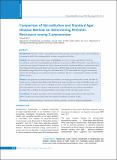Please use this identifier to cite or link to this item:
https://hdl.handle.net/20.500.14356/1807Full metadata record
| DC Field | Value | Language |
|---|---|---|
| dc.contributor.author | Yakoob, M Y | - |
| dc.date.accessioned | 2023-05-23T07:33:26Z | - |
| dc.date.available | 2023-05-23T07:33:26Z | - |
| dc.date.issued | 2014 | - |
| dc.identifier.citation | YakoobM. Y. (2014). Comparison of Microdilution and Standard Agar Dilution Method for Determining Penicillin Resistance among S.pneumoniae. Journal of Nepal Health Research Council. https://doi.org/10.33314/jnhrc.v0i0.500 | en_US |
| dc.identifier.issn | Print ISSN: 1727-5482; Online ISSN: 1999-6217 | - |
| dc.identifier.uri | http://103.69.126.140:8080/handle/20.500.14356/1807 | - |
| dc.description | Original Article | en_US |
| dc.description.abstract | Abstract Background: Antibiotic resistance among different microbial organisms is increasing. No study exists from Pakistan comparing methods of determining antibiotic resistance among bacterial isolates. Methods: Ten clinical patient sample strains of S.pneumoniae were used to compare agar dilution with broth microdilution method for determining Minimum Inhibitory Concentrations (MICs) of Penicillin G. Agar dilution was conducted as per National Committee for Clinical Laboratory Standards. Broth microdilution was performed in Brain Heart Infusion broth using sterile plastic microtiter trays with 96 U-shaped wells. In both methods, concentration of Penicillin G ranged from 0.03 to 16µg/mL and S.aureus ATCC 29213 with an MIC of 0.25µg/mL was used as a control. MIC =0.06µg/mL was considered sensitivity to antibiotic, MIC 0.12-1.0 intermediate resistance and MIC =2 full resistance. Results: Good agreement was found between two methods. Four strains gave identical MICs in both. The other six strains agreed to within one log2 dilution step. Both methods categorized same five strains as Penicillin sensitive and four as Penicillin resistant; one strain was classified as sensitive on agar dilution but resistant on broth microdilution. Broth microdilution was more expensive, tedious and time consuming than the agar dilution with multipoint inoculator. This would limit its clinical applicability in a busy diagnostic lab with a large sample turnover. Conclusions: We propose agar dilution for the clinical labs in developing countries that use Kirby-Bauer disk diffusion method and want to initiate MIC determination of antibiotics for patient samples.  Keywords: Minimum Inhibitory Concentration; Pakistan; penicillin; resistances; Streptococcus pneumoniae | en_US |
| dc.language.iso | en | en_US |
| dc.publisher | Nepal Health Research Council | en_US |
| dc.relation.ispartofseries | May-Aug, 2014;500 | - |
| dc.subject | Minimum Inhibitory Concentration | en_US |
| dc.subject | Pakistan | en_US |
| dc.subject | Penicillin | en_US |
| dc.subject | Resistances | en_US |
| dc.subject | Streptococcus pneumoniae | en_US |
| dc.title | Comparison of Microdilution and Standard Agar Dilution Method for Determining Penicillin Resistance among S.pneumoniae | en_US |
| dc.type | Journal Article | en_US |
| local.journal.category | Original Article | - |
| Appears in Collections: | Vol. 12 No. 2 Issue 27, May - Aug 2014 | |
Files in This Item:
| File | Description | Size | Format | |
|---|---|---|---|---|
| 500-Article Text-757-1-10-20141121.pdf | Fulltext Download | 96.32 kB | Adobe PDF |  View/Open |
Items in DSpace are protected by copyright, with all rights reserved, unless otherwise indicated.
